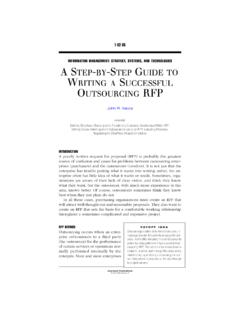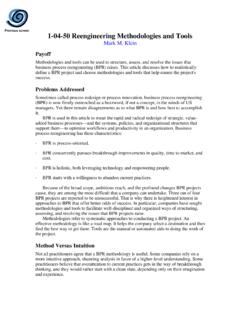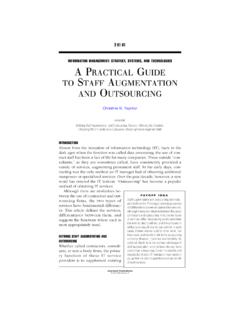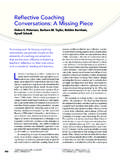Transcription of Leveraging the Benefits of Self-Directed Teams
1 1-03-65 Leveraging the Benefits of Self-Directed TeamsStewart L. Stokes, work Teams , a reaction to organizational downsizing and the exodus of scoresof middle managers, are increasingly being replaced by more traditional Teams . Yet, theself- directed experience has helped create the empowered and motivated professionals whoimplement today's redesigned business processes and holds valuable lessons for effectiveteam (or self -managed) work Teams became popular a few years ago, as humandownsizing (or rightsizing) occurred in numerous organizations. Self-Directed work teamswere often viewed as the magic bullet by which organizations could survive the exodus ofscores of middle managers.
2 The theory was that since the work still had to be done, and themanagers were no longer around to manage it, the remaining employees could manage is now time to assess progress toward self -direction and determine if the realitymatches the rhetoric. Are Self-Directed work Teams living up to their promise, or are theymerely a passing fad? As organizations continue to restructure and begin to benefit fromprocess reengineering, will self -direction wind up on the scrap heap of good but forgottenideas? Or, have Self-Directed team found their place in organizational strategy, modifiedperhaps, but still effective? self -Direction: Promise and RealitySelf-direction began as a response to the challenge of designing a tactical strategy to enablework groups and Teams to survive the outflow of middle managers and prepare to thrive inwhat were predicted to be fundamentally different organizational structures.
3 self -directedwork Teams , with little planning and less training, were thrust into corporate anddepartmental cultures as a knee-jerk reaction to the loss of middle-managementinfrastructure. It soon became apparent that lack of preparation, training, and support coulddoom this promising innovation to also became apparent that the organizational axiom of structure follows strategy (or,alternatively, form follows function) was being violated. Little thought was given to thestrategic consideration of how or even if self -direction would benefit the organization ordepartment, what it might cost to organize and train self -managing Teams , and what wouldbe required for self -management to succeed.
4 Instead, businesses focused on the seeminglyswollen ranks of middle managers and how they were becoming a drag on management was an inviting target for cost-cutting not only because of thesometimes bloated numbers of middle managers but also because of the excitementgenerated by process reengineering and the enabling power of new technologies. Ascompanies began to transform themselves from functionally-oriented, hierarchicalorganizations with clearly defined departmental boundaries to process-oriented, flatterorganizations with process owners instead of departmental managers, axes began to business processes were identified, departmental boundaries blurred, and cross-functional Teams took over responsibilities for process managers, who had been respected for years as the glue that held organizationstogether, discovered they were now an endangered species.
5 Managers who were deemed tohave requisite people skills were either invited to become team members (without amanagerial portfolio), given special assignments, or offered early retirement. Earlyretirement packages tended to be generous and many managers accepted them. Manyorganizations seriously underestimated the number of people who would leave and theeffects of the loss of organizational memory they took with move to self -management has been accompanied by boundless expectations. Theassumption that self -managed work Teams could take up the slack left by laid-off middlemanagers is seductive to the extreme, deluding those who survive rightsizing into believingthat the same amount of work (or even more) could be accomplished by fewer people.
6 Forself-management to work, however, people have to understand they are self -managing andtherefore able to be more productive because they are free of the constraints imposed byadditional layers of , though, it does not take long for those doing the work to recognize that acertain amount of work takes a certain amount of time, and that self -management is notnecessarily the critical variable. (As a matter of fact, it might take a self -managed team evenlonger if its members receive little or no training, as frequently has been the case.) Thepointed question, What did those managers do, anyway? is then replaced by moreappropriate questions, including, What is the real problem here, and why?
7 And How mightthe team secure the resources it is going to need to accomplish this project? The importanceof training in soft skills ( , interpersonal communication, influencing without authority,negotiation, group dynamics, facilitating, conflict management, and presentationskills)becomes increasingly apparent as Self-Directed team wrestle with the ever-presentorganizational of the most significant lessons self -managed Teams have learned is how muchtime it takes to manage a task, in addition to doing it. Members of self -managing teamsfrequently find themselves arriving early and staying late to handle the planning andcoordinating aspects of their responsibilities.
8 Although some team members perceive theseas career-enhancing opportunities, others see them as encroachments on their personaltime. The social contracts had been rewritten, and not everyone was 's In Charge Here?As self -managing Teams struggle with the managerial issues of planning, coordinating,controlling, and evaluating, they frequently ask that most difficult question, Why? Why isthis work being done this way? Why is it being done at all? The why soon leads to the what. What is the purpose of this activity/task/step? What does it accomplish? What isits contribution?Reengineering the Flattened OrganizationThe asking of such questions is part of the Great Reengineering Revolution, that waveof enterprise restructuring that is reaching into almost every enterprise.
9 In some cases,reengineering is being attempted through the blank-slate approach of completelyreinventing the enterprise of reconceiving it not in terms of separate, departmental,vertical functions but in terms of horizontal, integrated, cross-functional processes. In othercases, reengineering is being approached more cautiously, in terms of incrementalimprovement to individual tasks and activities and not necessarily the complete obliterationof entire functions and of these fundamental approaches to reengineering has its own cadre ofcommitted even fervent devotees, and the merits of each approach can be arguedpersuasively.
10 It is important to note that both approaches encompass reviewing, revising,and often expanding the parameters of individual jobs and scopes of responsibility, and theability to be Self-Directed in managing these new accountabilities is crucial for team andpersonal success. As organizations and departments restructure themselves, there is oftenlittle (if any) relevant history or prior experience to fall back on. The mental models thatexplain how hierarchical organizations work have limited application in flatterorganizations. A high value is placed, therefore, on the willingness and ability of people enhanced by training and supported by recognition and rewards to think outside the box:to be proactive and to initiate, innovate, and improve all aspects of tasks and Abhors a Managerial VacuumAs Self-Directed team have attempted to gain acceptance, two other natural laws assertthemselves: Every action has an equal and opposite reaction, and Nature abhors avacuum.















